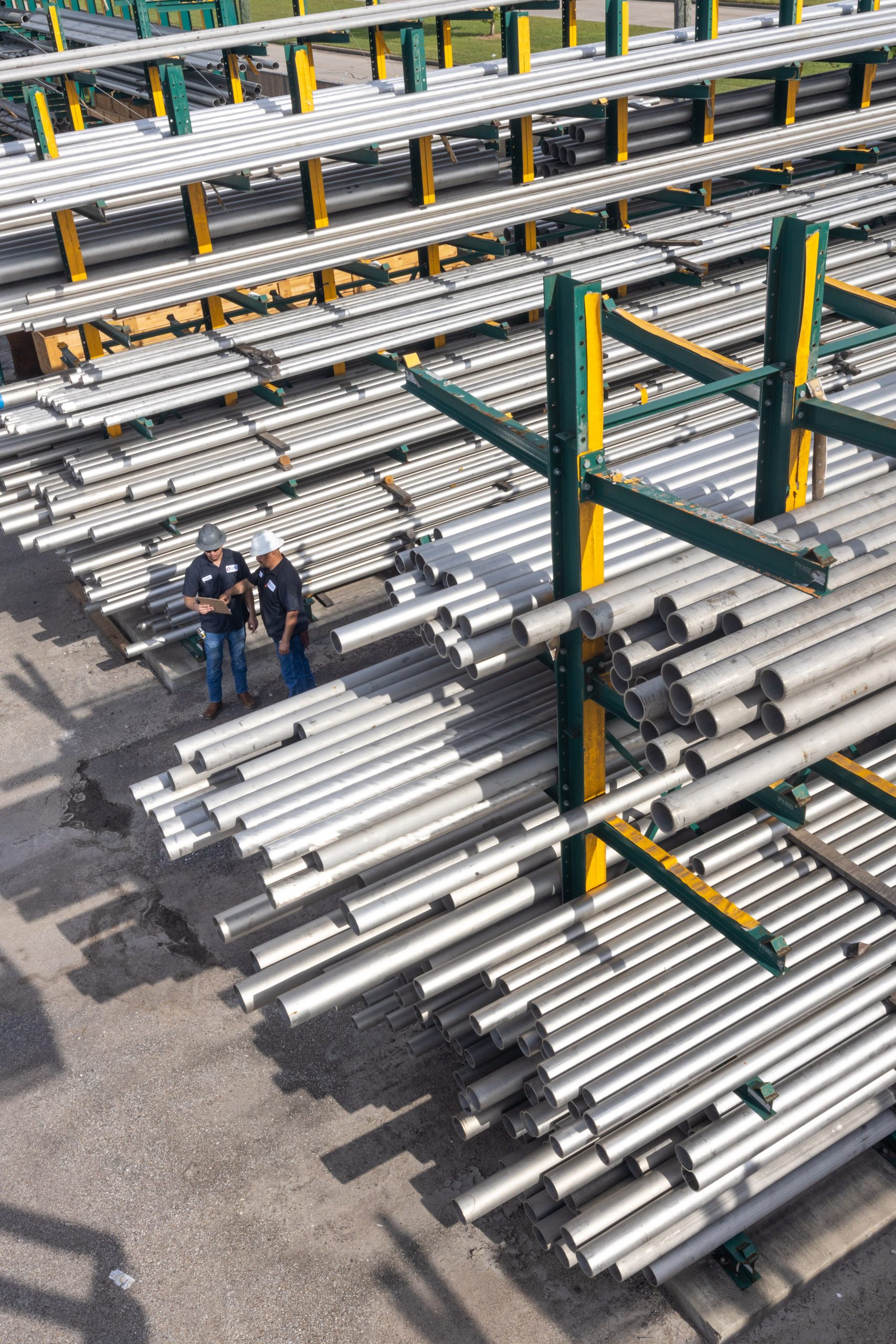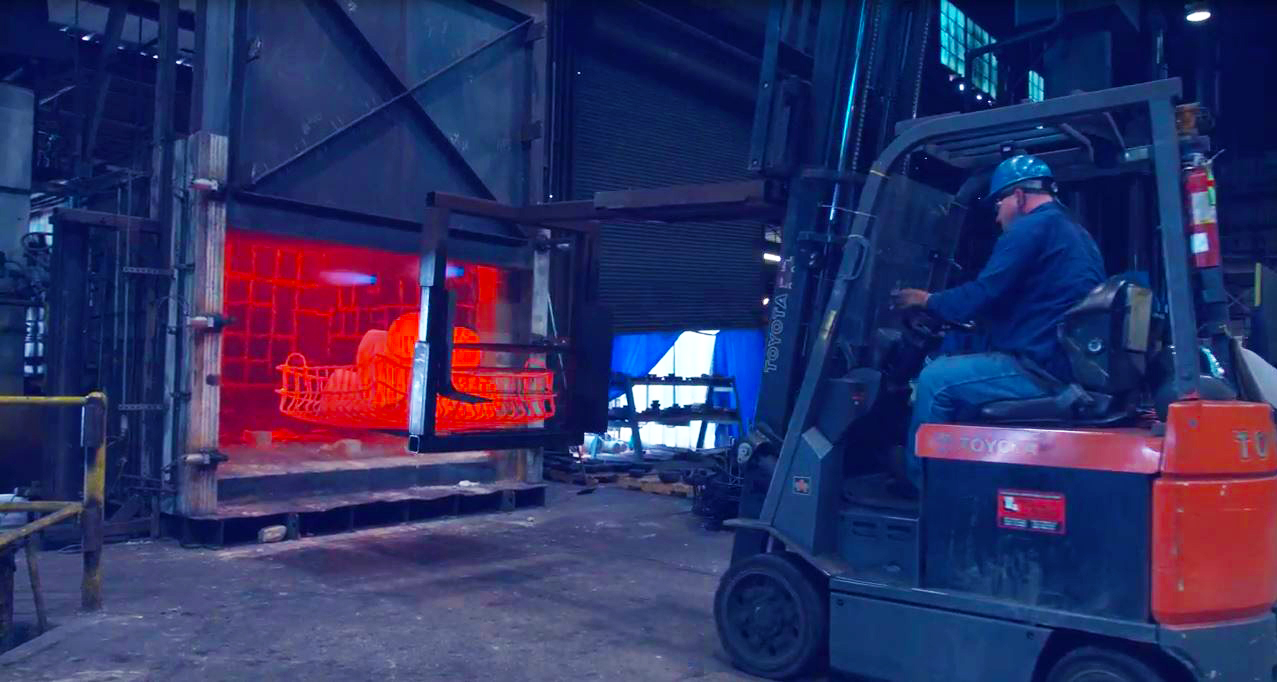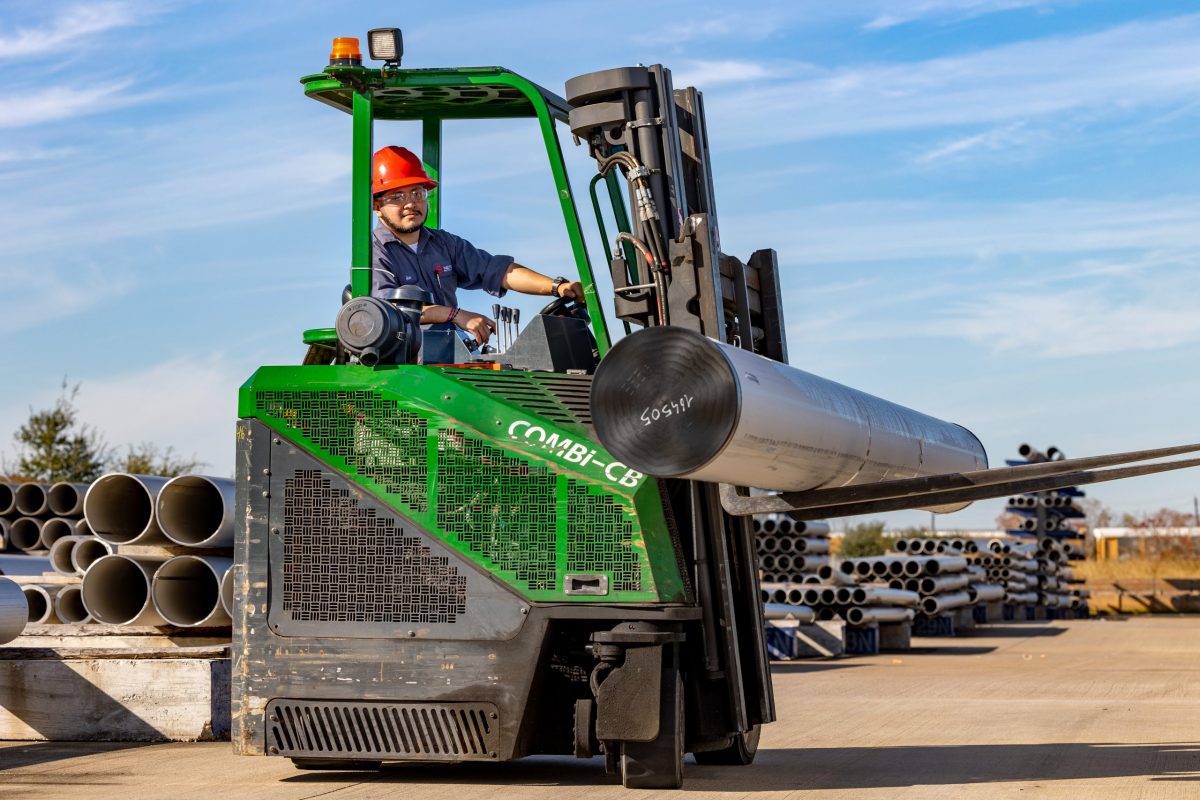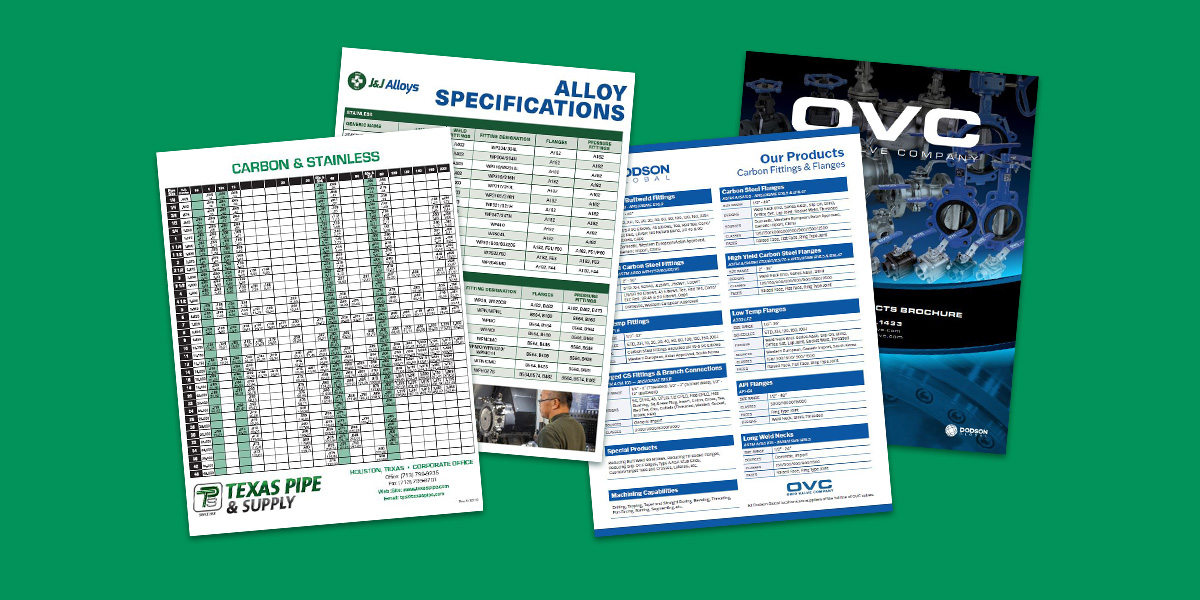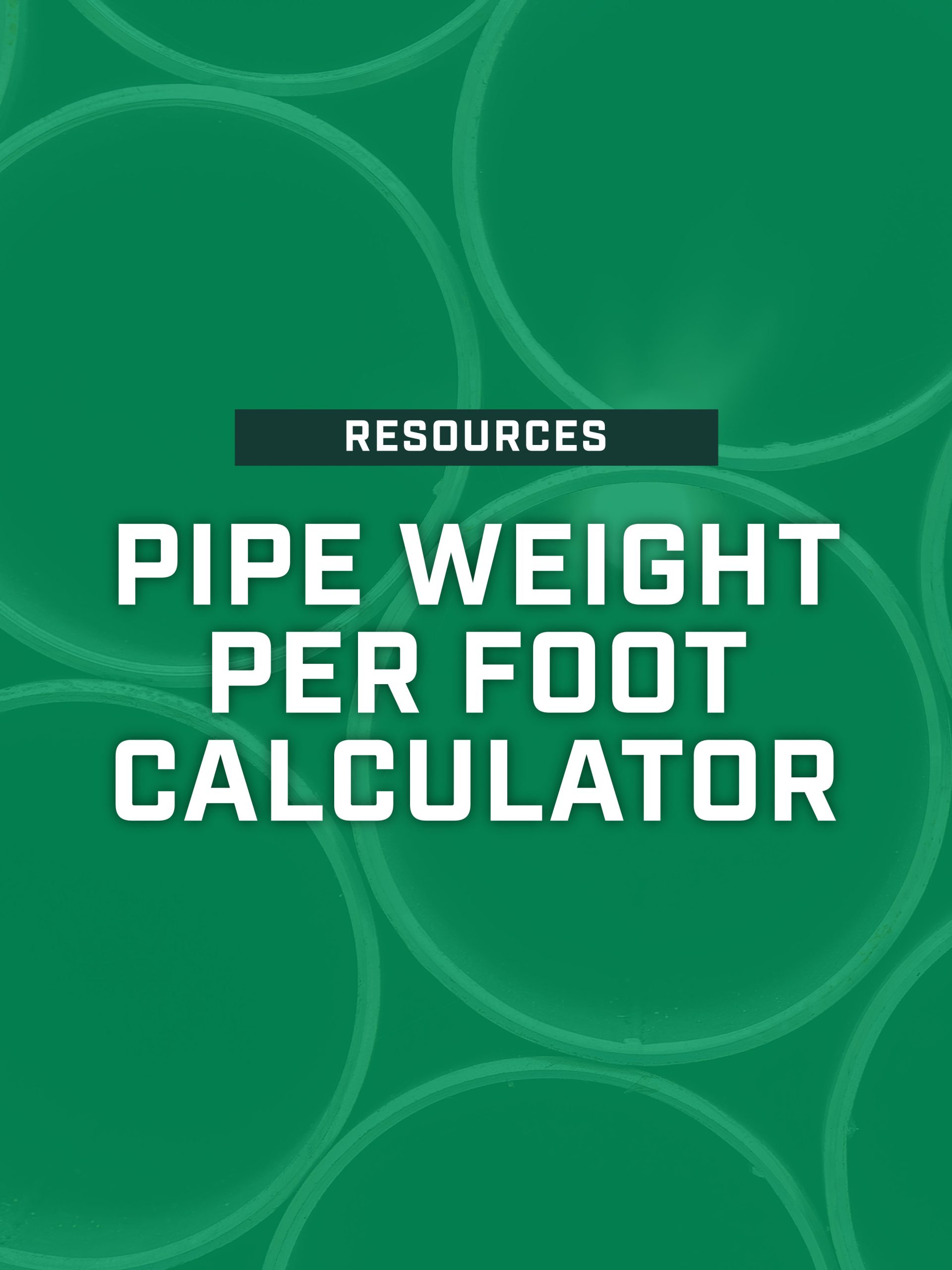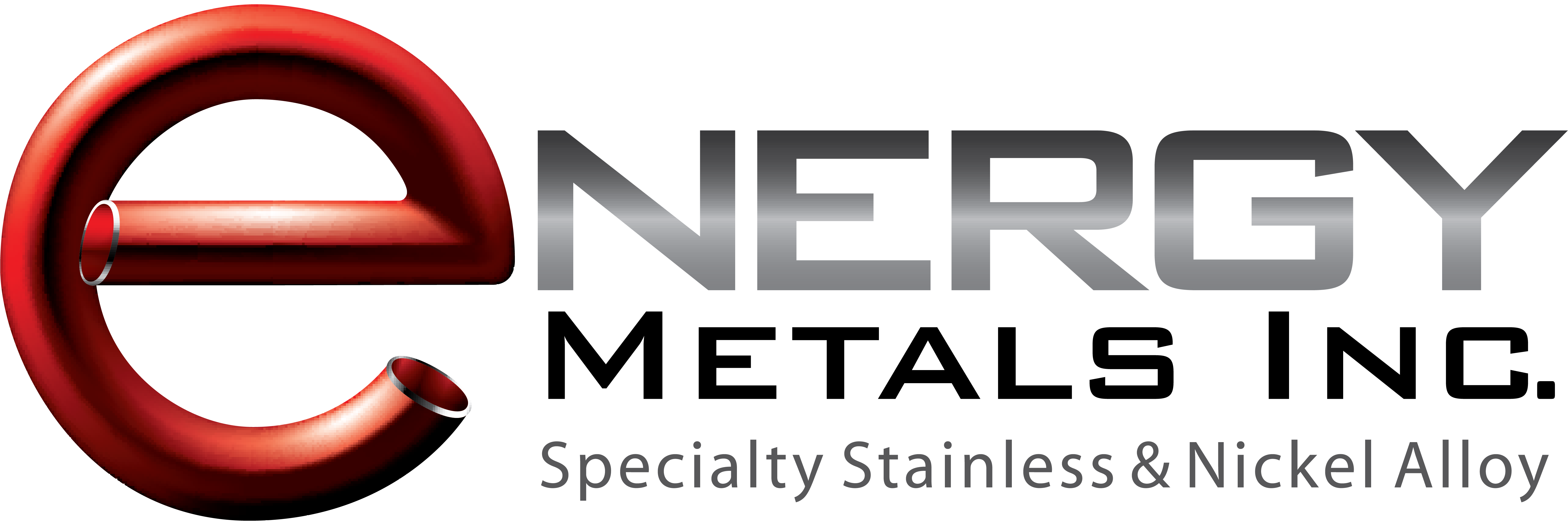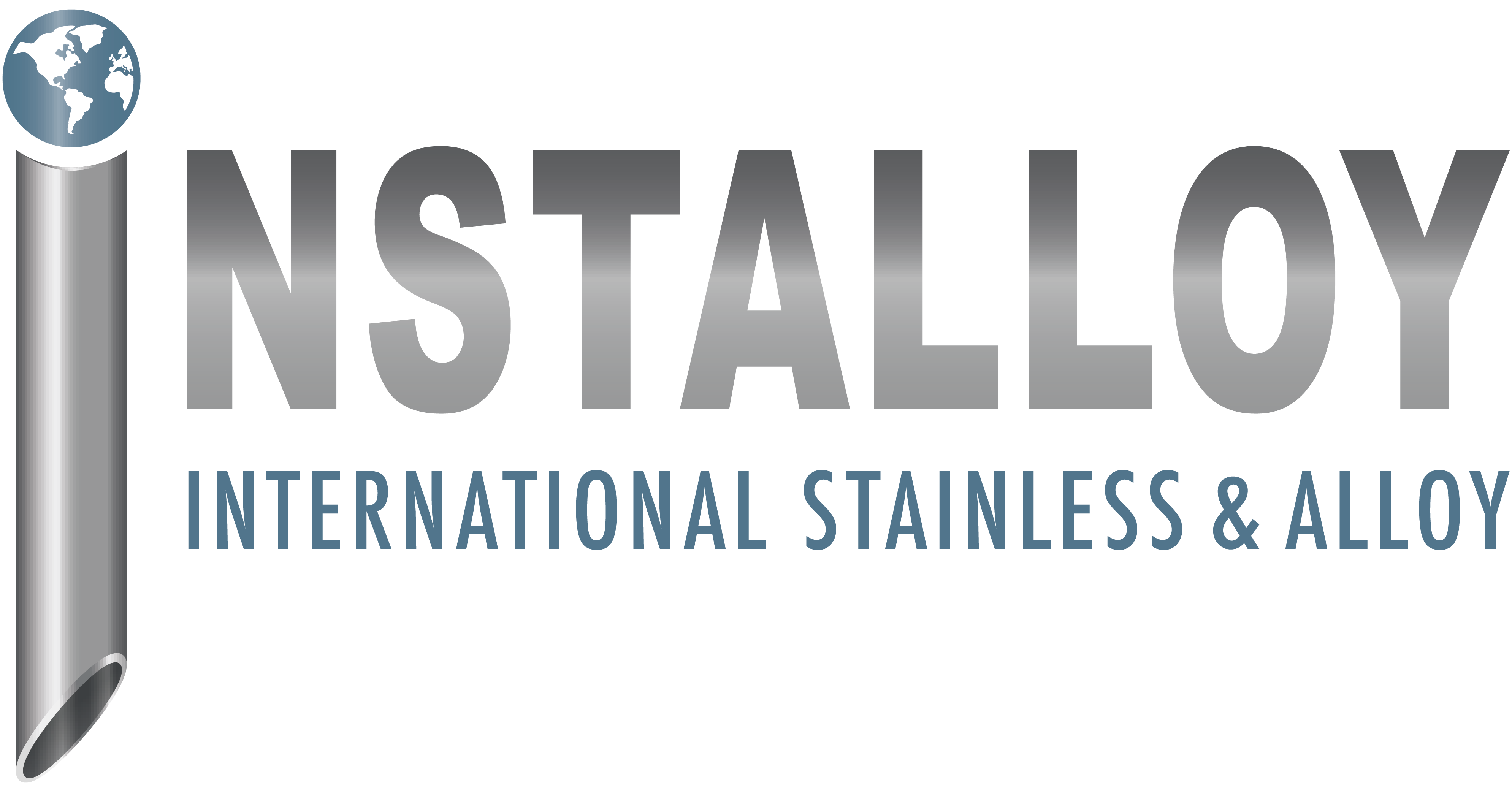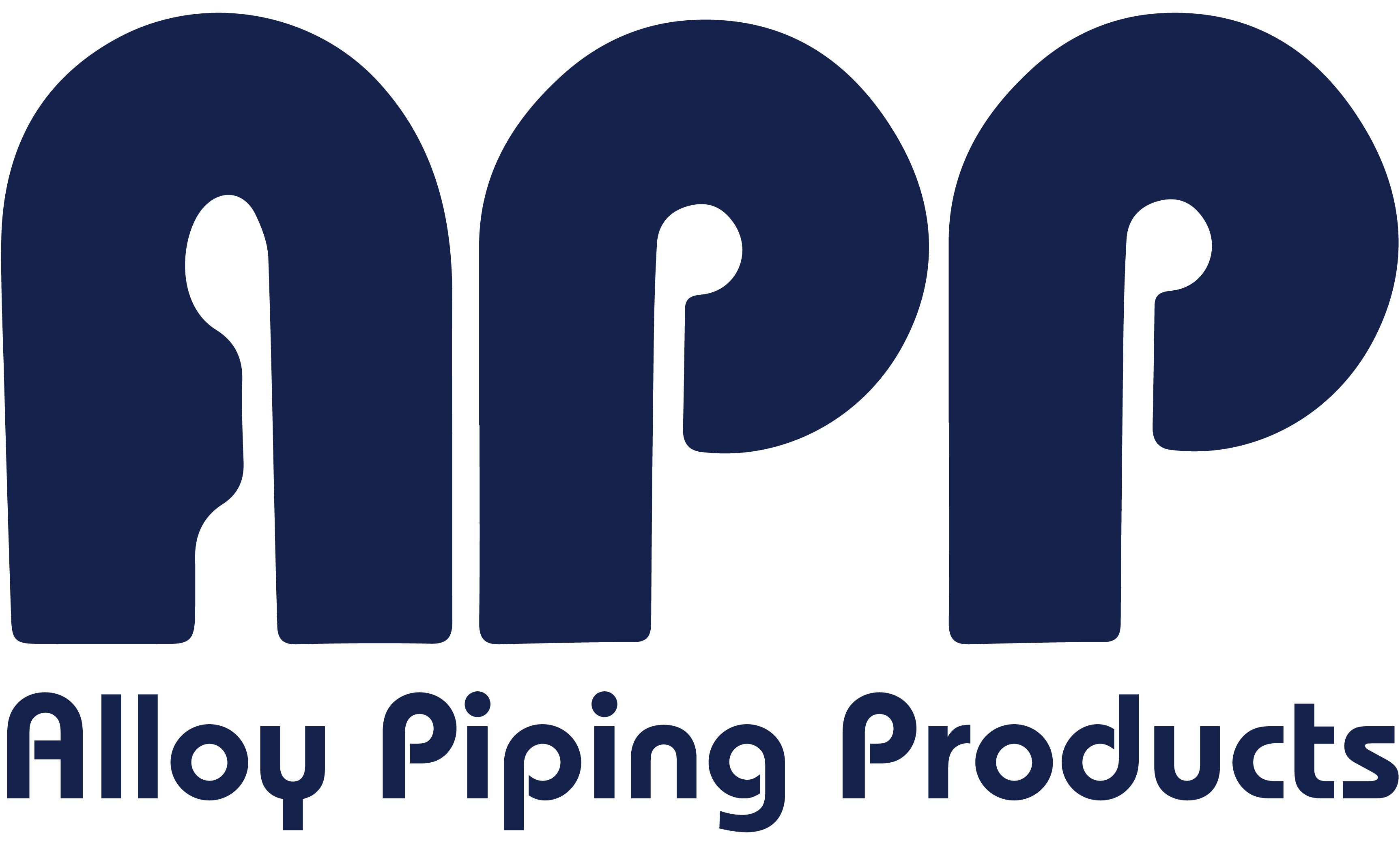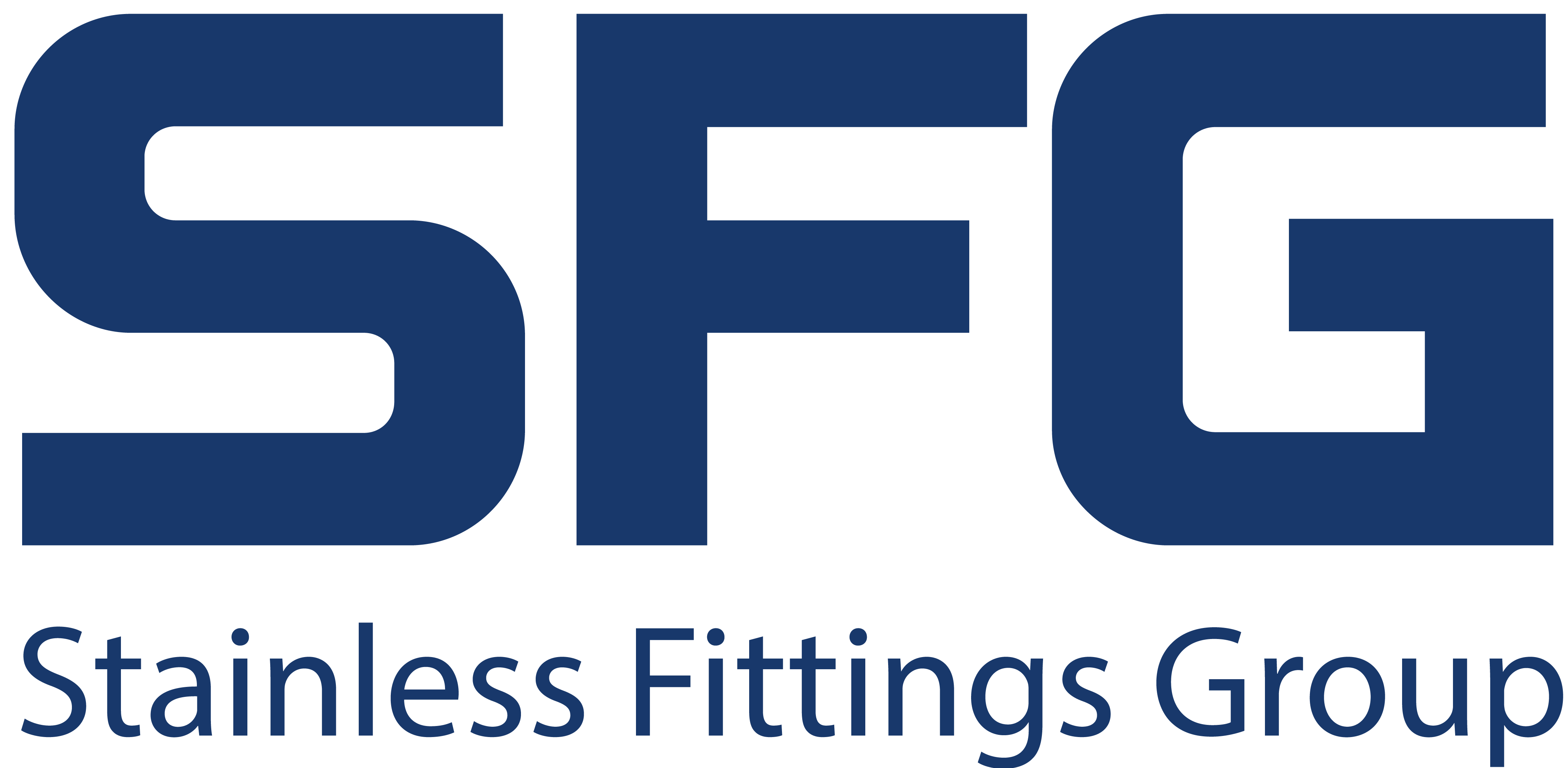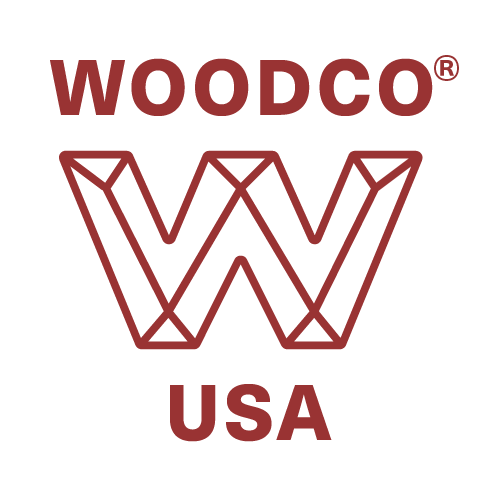PVF Glossary
a
ACETYLENE WELDING – Welding by using the acetylene torch for fusing a selected metal (welding rod) in such a position as to fill up the space where a junction is to be made (see welding).
ALLOY – A substance that has metallic properties and is composed of two or more chemical elements of which at least one is a metal. Used to change the properties of steel.
ALLOY STEEL – Steel is commercially classified as alloy when the maximum of the range given for the content of alloying elements exceeds one or more of the following, manganese, 1.65%; silicon, 0.60%; copper, 0.60%; or in which a definite range or a definite minimum quantity of any of the following elements is specified or required within the limits of the recognized field of constructional alloy steels; aluminum, boron, chromium up to 3.99%, cobalt, columbium, molybdenum, nickel, titanium, tungsten, vanadium, zirconium, silicon, and copper.
ALLOYING ELEMENTS – Chemical elements added for improving the properties of the finished products. Chief alloying elements in medium alloy steels are: nickel, chromium, manganese, molybdenum, vanadium, silicon, and copper.
ANNEALING – A process involving the heating of steel to above critical temperature. Usually applied to induce softening. The term also refers to treatments intended to alter mechanical or physical properties, produce a definite microstructure, or to remove gases. Desired properties of the steel are developed by controlling the cooling rate.
ANSI – American National Standards Institute
API – A process involving the heating of steel to above critical temperature. Usually applied to induce softening. The term also refers to treatments intended to alter mechanical or physical properties, produce a definite microstructure, or to remove gases. Desired properties of the steel are developed by controlling the cooling rate.
ARC PITS – Sometimes referred to as contact burns. Usually a series of small pits or indentations adjacent to, or on the weld surface, caused by electrical arcing between the electrode and the pipe surface.
ARC WELDING – Welding accomplished by using an electric arc that may be formed between a metal or carbon electrode and the metal being welded; between two separate electrodes, as in atomic hydrogen welding; or between two separate pieces being welded, as in flash welding.
ASME – American Society of Mechanical Engineers
ASTM – American Society of Testing Materials
b
BAD BEVEL – Ends on which the angle of bevel or width of root face does to meet the pipe standard designated in the purchase order specifications.
BAR HOT ROLLED – Produced from ingots, blooms or billets covering the following ranges: roughs- 3/8” to 8-1/4”, inclusive; squares- 3/8” to 5-1/2″, inclusive; round-cornered squares- 3/8″ to 8”, inclusive; hexagons- 1/4″ to 4-1/6″, inclusive; plates – 13/64” (0.2031) and over in specified thickness, and not over 6” specified width. Standard and special shapes: angles, channels, tees, and zees; when their greatest cross-sectional dimension is under 3”; and ovals, half-ovals and half-rounds. Also, special shapes are available.
BEND TEST – Various tests used to determine the ductility of sheet, plate, or tubulars that are subjected to bending. These tests may include determination of the minimum radius or diameter required to make a satisfactory bend, and the number of repeated bends that the material can withstand without failure when it is bent through a given angle and over a definite radius.
BEVEL – Taper at the pipe end to provide a proper shape void for welding when two joints are butted end to end.
BILLET – A semifinished piece of steel resulting from the rolling of ingot or a bloom. It may be square, but is never more than twice as wide as it is thick. Its cross-sectional area usually is not more than 36 sq. in.
BLISTER – A raised spot on the surface of the pipe caused by the expansion of gas in a cavity within the pipe wall.
BLOOM – A semifinished piece of steel, resulting from the rolling or forging of an ingot. A bloom is square or not more than twice as wide as it is thick, and usually is not less than 36 sq. in. in cross-sectional area.
BLOWHOLE – An internal cavity in steel produced during the solidification of the metal by evolved gas which, in failing to escape, is held in pockets.
BRAZING – Joining metals by fusing of nonferrous alloys that have melting points above 800℉, but lower than those of the metals being joined. This may be accomplished by means of a torch (torch brazing), in a furnace (furnace brazing), or by dipping the metals in a molten flux bath (dip or flux brazing). The filler metal ordinarily is in rod form in torch brazing; whereas in furnace and dip brazing, the work material first is assembled and the filler metal may then be applied as wire, washer, clips, bands, or may be integrally bonded, as in brazing sheet.
BURNT – A term applied to metal permanently damaged by having been heated to a temperature close to the melting point.
BUTT JOINT – A joint between two members lying approximately in the same plane.
BUTT WELDING – Joining two edges or ends by placing one against the other and welding them.
c
CARBON STEEL – Steel which owes it properties chiefly to various percentages of carbon, without substantial amounts of other alloying elements. It also is known as steel when no minimum content of elements other than carbon is specified or required to obtain a desired alloying effect; or when the specified minimum for copper does not exceed a 0.40%; or when the maximum content for the following does not exceed the percentages noted: manganese, 1.65; silicon, 0.60; and copper, 0.60.
CHARPY TEST – A method for measuring the amount of energy absorbed by a notched specimen during fracture as a result of an impact load.
CHAMFER – To cut or bevel tubing or pipe at an angle.
CHECK ANALYSIS – A chemical analysis of the metal after it has been rolled or forged into semifinished or finished forms.
COATING – The process of covering steel with another material, primarily for corrosion resistance.
COLD ROLLED PRODUCTS – Flat-rolled products which have been finished by rolling the piece without heating (at approximately room temperature).
COLUMBIUM – An alloying element added to high strength low alloy steels. It retards grain growth and recrystallization during controlled rolling, and increases strength.
CONTINUOUS MILL – A mill composed of several strands of rolls arranged “in tandem,” usually so close together that the steel being rolled is passing through several strands simultaneously. Examples: bar mills, strip mills, continuous weld and ERW pipe mills.
COUPLING – Threaded sleeve used to connect two lengths of threaded pipe.
CRACK – A stress-induced separation of the metal which, without any other influence, is insufficient in extent to cause a complete rupture of the material.
CRACK, HOOK – Metal separations resulting from imperfections at the edge of the plate or skelp, parallel to the surface, which turn towards the I.D. or O.D. surfaces when the edges are upset during welding.
CRACK, WELD AREA – A stress-induced separation of the metal which, without any other influence, is insufficient in extent to cause complete rupture of the weld.
CROOKED PIPE – Pipe that deviates from straightness as measured along a line parallel to the longitudinal axis of the pipe in excess of that permitted in the pipe standard designated in the purchase order specifications. The crooked condition can be a bow, or it can be a “hooked end.”
CROP – The end or ends of an ingot or rolled product that contain the pipe or other defects to be cut off and discarded. It also is termed a “crop end” and “discard.”
d
DAMAGED BEVEL – A nick, burr, or other defect in the machined surface of the bevel that would interfere with making a good metal.
DAMAGED SURFACE – Any defect mechanically imparted to the surface other than a dent.
DEBRIS – Superfluous material resting on or attached to the internal or external surfaces of the pipe.
DEFECTIVE FLASH TRIM – Associated with electric-resistance welded pipe, where the flash trim has not been removed to a height meeting the pipe standard designated in the purchase order specifications; where the flash bead is removed in such a way that is ragged, rolled or has sharp edges.
DENTS – A local change in surface contour by mechanical impact, but not accompanied by loss of metal. (Also referred to as balls or dinged.)
DESCALING – The process of removing scale from the surface of steel. Scale forms most readily when the steel is hot by the union of oxygen and iron. Common methods of descaling are: crack the scale by the use of roughened rolls, and remove it by a high-pressure water spray; and throw salt, wet sand, or wet burlap on the steel immediately before its passage through the rolls.
DIE STAMPING – Mechanically stamping of identification numbers in the body of the pipe.
DOUBLE JOINTED – Two standard length pipe joints welded together to form a single joint of double length.
DRL – Double Random Lengths; minimum average lengths 35′, shortest length permissible is 14′.
DUCTILITY – The property that permits permanent deformation before fracture by stress in tension.
DROP WEIGHT TEAR TEST – An impact test used to determine the nil ductility transition temperature of ferritic steel.
e
EDDY CURRENT TESTING – A nondestructive testing method in which an eddy current flow is induced in the test object. Changes in the flow caused by variations in the specimen are detected by a nearby electromagnetic coil for subsequent analysis by suitable instrumentation and techniques.
EDGE CONDITION – A mill edge is the normal edge produced in rolling, and does not conform to any definite contour. A sheared edge is one that has been cut after rolling. A slit edge results when a strip is cut into multiple widths by means of a rotary knife.
ELASTIC DEFORMATION – The temporary changes caused in dimensions by stress. The material returns to the original dimensions after the stress has been removed.
ELASTIC LIMIT – The maximum stress which a material is capable of sustaining without any measurable permanent extension remaining after the complex release of the applied force.
ENDS BELLED OR CUPPED – A difference between the end I.D.s of a joint that is greater than the welding tolerances permit.
ENDS OUT-OF-SQUARE – The plane of the machined end of the pipe is not normal to the longitudinal axis of the pipe, causing the tolerance to vary in excess of the permitted in the pipe standard designated in the purchase order specifications.
ERW – Electric Resistance Welded
ETCHING – In metallography, the process of revealing structural details by the preferential attack of reagents on a metal surface.
EUE – External Upset Ends
EXCESS REINFORCEMENT – (Excessive over-fill)- Outside weld beads which extend above the prolongation of the original surface of the pipe (more than 1/8″ for pipe having a thickness of 1/2″ and under, and more than 3/16” for a pipe having a thickness greater than 1/2″).
EXPANDERS – Mechanical devices used to expand pipe to obtain increased transverse yield strength and the desired O.D. size.
EXPANDER MARKS – Occur when the mechanical expander does not give an even or overlapping expansion; or when an internal expander’s shoe(s) fail to operate, leaving a flat section(s) parallel to the longitudinal axis of the pipe.
f
FLAME CUTTING – Severing a piece of steel by burning away a portion of it by means of an oxyacetylene torch; or by removing part of the surface by means of the burning torch, as in conditioning. (More properly called “scarfing.”)
FRACTURE TEST – Breaking a piece of metal for the purpose of examining the fractured surface to determine the structure of carbon content of the metal, or to detect the presence of the internal defects.
g
GALVANIZING – The process of applying a coating of zinc to the finished cold-reduced sheet or to fabricated parts made from strip products. The coating is applied by hot dipping or electrolytic deposition.
GAS CUTTING – Cutting material with a gas torch rather than by shearing. This operation may set up undesirable stresses in the material near the cut edges due to thermal effects; although such stresses can be relieved by suitable heat treatments. Same as flame cutting.
GAUGES – A measurement of thickness. There are various standard gauges such as United States Standard Gauge (USSG), Galvanized Sheet Gauge (GSG), and the Birmingham Wire Gauge (BWG).
GAUGE SIZE – BIG – Excessive standoff when the working ring gauge is screwed onto the pipe.
GAUGE SIZE – SMALL- Insufficient standoff when the working ring gauge is screwed onto the pipe.
GOUGE – Elongated grooves or cavities caused by the mechanical removal of metal.
GOUGE BY FLASH TRIMMER – Associated with electric-resistance welded steel line pipe. This occurs in the resistance welding process, when the tool used to remove the flash digs too deeply; and thus actually removes not only the welded flash itself, but also the parent metal adjacent to the weld.
GRADE – The term grade designates divisions within different types based on carbon content or mechanical properties; for example: “This is a high tensile (grade) structural steel.”
GRINDING – A method of conditioning steel which uses a power-driven grinding wheel.
GRINDING EXCESSIVE OR DEEP – Where the grinding of defects to bring a metal pipe product within compliance causes its wall thickness to be reduced below the specified minimum requirements.
GRIND – POOR – Results from a ground area on which the grind is very coarse, or has not been blended into the natural contour of the pipe, thus leaving a sharp edge or ridge.
h
HARDNESS – Defined in terms (usually stated as a Rockwell number, Brinell number or Vicker number) of the method of measurement. Usually, it refers to the resistance to indentation; stiffness or temper of wrought products; or machinability characteristics.
HARD SPOT – High hardness areas created during hot rolling of plate by localized quenching. These hard spots are circular in shape, and occur in various diameters. Hardness readings, as indicated, reach a tensile strength ranging from 130,000 to 200,000 psi in the center portion of the spot; and consist of untampered martinsite, and low- and high-temperature bainite.
HEAT – A form of energy which raises the temperature of bodies into which it is absorbed. Heat also means an individual bath of metal as it is melted in a furnace.
HEAT TREATMENT – A combination of heating and cooling operations applied to a metal or alloy in the solid state to obtain desired conditions or properties.
HIGH STRENGTH STEEL – Low alloy steels forming a specific class in which enhanced mechanical properties and, in most cases, good resistance to atmospheric corrosion are obtained by the incorporation of moderate proportions of one or more alloying elements other than carbon. The preferred terminology now is “high strength, low alloy steels.”
HOT ROLLED – Hot rolled products are those products which are rolled to finish at temperatures above the metal’s recrystallization temperature.
HYDROSTATIC – Type of pipe pressure test using compressed water.
i
ID – Inside Diameter
IMPACT TEST – A test to determine the energy absorbed in fracturing a test bar at high velocity. The test may be in tension or in bending; or it may properly be a notch test if a notch is present, creating multiaxial stresses.
INCLUSIONS – Nonmetallic solid materials entrapped in the weld deposit or between the weld metal and base metal. Also found in base metal not associated with the weld.
INCOMPLETE FUSION (COLD WELD) – Lack of complete coalescence of some portion of the metal in a weld joint.
INGOT – Steel formally in a molten state, and transferred to an ingot mold to solidify.
IPS – Iron Pipe Size
j
JOINTERS – Two or more pieces of pipe welded together to make a standard length as designated in the purchase order specifications.
k
No results.
l
LADLE – A large vessel into which molten metal or molten slag is received and handled. Molten metal may be transported short distances by carrying it in a ladle.
LADLE ANALYSIS – The term applied to the chemical analysis representative of a heat or blow of steel, and is the analysis reported to the purchaser. It is determined by analyzing (for such elements as have been specified) a test ingot sample obtained from the first part or middle part of the heat or blow during the pouring of the steel from a ladle.
LAMINATION – An internal metal separation creating layers generally parallel to the surface.
LAND – Face at pipe and between the bevel and the interior surface.
LAP – Fold of metal which has been rolled or otherwise worked against the surface of rolled metal, but has not fused into sound metal.
LAP WELD – A term applied to a weld formed by lapping two pieces of metal and then pressing or hammering; applied particularly to the longitudinal joint produced by a welding process for tubes or pipe in which the edges of the skelp are beveled or scarfed so that, when they are over-lapped, they can be welded together.
LINE PIPE – This is steel pipe used for the transportation of gas, oil, and water. Its size ranges from 1/8” nominal to 48” O.D. in a wide range of wall thicknesses. It generally is produced to API (American Petroleum Institute) specifications.
LIQUID PENETRANT – A nondestructive testing method utilizing liquid penetrants for detecting discontinuities that are open to the surface.
LOT SIZE – Total number of pipe joints in one batch.
LTC – Long Threads and Couplings
m
MAGNAFLUX TEST – An inspection given to important or highly stressed parts or pipe for critical applications. It consists of suitably magnetizing the material and applying a prepared magnetic powder which adheres to it along the lines of flux leakage. It shows the existence of surface and subsurface discontinuities.
MAGNETIC PARTICLE INSPECTION – A nondestructive testing method using iron powder and electromagnetic current for detecting cracks and other discontinuities at or near the surface in ferromagnetic materials.
MAGNETIC TESTING – The magnaflux of testing to detect internal discontinuities, performed by magnetizing the bar and sprinkling it with a magnetic powder which can be applied to detect flaws or defects on the surface.
MANDREL – A rod used to retain the cavity in hollow metal products during working. Also, a metal bar around which other metal may be cast, bent, formed, or shaped.
MARKING – Method(s) used to establish the identification of pipe.
MECHANICAL PROPERTIES – Those properties of a material that reveal the elastic and inelastic reaction when force is applied, or that involve the relationship stress and strain. For example, common mechanical properties include the modulus of elasticity, tensile strength and the fatigue limit. These properties often have been designated as “physical properties,” but the term “mechanical properties” is preferred.
MECHANICAL WORKING – Subjecting metal to pressure exerted by rolls, dies, presses, or hammers in order to change its form to affect the structure and, consequently, the mechanical and physical properties known as wrought metals.
METALLURGY – The science which deals with the extraction of metals from their ores and the adaptation and application of these metals to the use for which they are intended.
MID-WELDS – Two or more joints of pipe welded together to form one long joint.
MILL EDGE – The normal rounded edge produced in hot rolling. It does not conform to any standard radius. This replaces the old term, band edge.
MILL FINISH – A surface finish produced on sheet and plate, characteristic of the ground finish on the rolls used in fabrication.
MILL LENGTH – Those lengths which can be most economically handled by the mill. Upper and lower limits are set by equipment limitations in the mill.
MOLYBDENUM – A special alloying element commonly used to increase the hardenability of steel. Molybdenum is sometimes added to stainless steel to enhance its corrosion resistance to certain chemicals. Molybdenum is commonly called “moly.”
n
NDE – Nondestructive examination uses nondestructive testing methods; primarily eddy current, liquid penetrant, magnetic particle, radiography, and ultrasonics.
NOMINAL (NOM) – Name given to designate standard pipe size.
NONCOMPLIANCE – Specific variation in procedure contrary to specifications.
NONCONFORMITY – Irregularity occurring beyond normal limits.
NORMALIZE – The normalization process which is commonly applied to steel articles of heavy section consists of heating the metal to a temperature of about 100℉. above the critical range, and cooling it in still air.
o
OD – Outside Diameter
OD – BIG – Outside diameter at pipe ends in excess of that allowed in the pipe standard designated in the purchase order specifications.
OD – SMALL – Outside diameter of pipe ends under that allowed in the pipe standard designated in the purchase order specifications.
OFFSET OF PLATE EDGES – The radial offset of plate edges in the weld seams.
OFFSET WELD BEAD – (Misalignment of weld seams, out-of-line weld bead or offseam weld bead) – Applies to submerged arc-welded pipe, wherein the inner and/or outer weld beads are out-of-radial alignment with the abutting edges of the joints.
OUT-OF-ROUNDNESS – Pipe which is oval or egg shaped and on which the major and/or minor axes are respectively in excess or less than the tolerances permitted in the pipe standard designated in the purchase order specifications.
p
PE – Plain End
PE&B – Plain End and Beveled
PENETRATOR – (See INCOMPLETE FUSION)
PERMANENT RECORDS – All designated records that must be kept on file in compliance with applicable codes.
PROPERTIES – PHYSICAL – Those properties familiarly discussed in physics; exclusive of those described under mechanical properties; such as density, electrical conductivity, and the coefficient of thermal expansion. This term often has been used to describe mechanical properties, but this usage is not recommended. See Mechanical Properties.
PINHOLES – (See POROSITY)
PICKLING – Chemical or electrochemical removal of surface oxides.
PILING – A form of rolled structural shape of two types: sheet piling and bearing piling. The three forms of sheet pile – straight, arch type and zee – are used in the construction of docks, breakwaters, coffer dams, etc. Bearing piles ranging from 14” to 8” in depth are heavy, wide flange sections for foundation work, etc.
PIPE BODY – Is that area between the beveled or threaded ends.
PIT – A depression resulting from the removal of foreign material rolled into surface during manufacture.
PITTED STEEL – A depression remaining in the pipe surface after the removal of foreign material rolled into the surface during manufacturing.
PLATE – Carbon steel plate is comprised of flat rolled finished steel products within the following size limitations:
0.0180” or thicker, over 48” wide
0.0230” or thicker, over 6” wide
7.53 lb./sq. ft. or heavier, over 48” wide
9.62 lb./sq. ft. or heavier, over 6” wide
PLUG SCORE – The internal, longitudinal grooves occurring on the inside of seamless pipe, usually caused by hard pieces of metal adhering to the high-mill plug.
POROSITY – Unsoundness in cast metals caused by the presence of blowholes and shrinkage cavities. (Also referred to as pinholes or gas pockets.) Cavities in weld caused by gas entrapped during the solidification process.
PREHEATING – A general term used to describe heating applied as a preliminary to some additional thermal or mechanical treatment. Also, a term applied specifically to tool steel to describe a process in which the steel is heated slowly and uniformly to a temperature below the hardening temperature, and then is transferred to a furnace in which the temperature is substantially above the preheating temperature.
PSI – Pounds per Square Inch
q
QUALITY – Refers to the acceptability of the steel and the pipe for the purpose or purposes for which it is purchased.
QUENCHING – A process of rapid cooling from an elevated temperature by contact with liquids, gases or solids.
r
R&D – Reamed and Drifted
RADIOGRAPHY – A nondestructive testing method using x-ray or gamma radiation to detect discontinuities in material, and to permanently record their images.
RANDOM LENGTH – Length can be specified but, if random length are permitted, cutters have a spread of from 2 to 5 feet depending on ordered length and size.
REJECTS – Sheets – a secondary product of a single size and gauge. Plates- a specific size and gauge containing minor defects. Pipe- joints that do not meet specifications.
RL – Random Lengths (See RANDOM LENGHT)
ROLL MARKS – Imperfections in the pipe surface usually caused by improper roll alignment or a chip or other imperfection in the roll itself.
s
SCAB – An imperfection in the form of a shell or veneer, generally attached to the surface by sound metal. It usually has its origin in an ingot defect.
SCABBY STEEL – Technically the same as silvered steel except that the shape of the thin piece of metal attached to the body of the pipe usually is more rounded.
SCALE – An oxide of iron which forms on the surface of hot steel. Sometimes it forms in large sheets which fall off when the steel is rolled. (Also see Roll Scale.)
SCARFING – Cutting surface areas of metal objects, ordinarily by using a gas torch. The operation permits surface defects to be cut from ingot, billet, or the edges of plate that is to be beveled for butt welding. See Chipping.
SCRAP – Iron or steel discard, cuttings, or junk metal which can be reprocessed.
SCRAPPING – The act of discarding a piece of steel or of cutting it into sizes convenient for handing as scrap.
SEAM – On the surface of metal, a crack that has been closed but not welded; usually produced by some defect either in casting or in working, such as blowholes that have become oxidized, or fold and laps that have been formed during working.
SEAMY STEEL – A crevice in rolled metal which has been almost closed by rolling or other working, but has not been fully fused into sound metal.
SILICO MANGANESE – An alloy containing silicon and manganese. In the open hearth process, it is used as a deoxidizer in the furnace and for the introduction of manganese and silicon into steel.
SINGLE RANDOM LENGTHS – Minimum average lengths 17′ 6″; shortest length permissible is 9′.
SKELP – A plate of steel or wrought iron from which pipe or tubing is made by rolling the skelp into shape longitudinally, and welding or riveting the edges together.
SLAB – A semifinished block of steel cut from a rolled ingot, with its width at least twice its thickness. It differs from a bloom, which is more or less square. Slabs are the product of a slabbing mill or a blooming mill.
SLAG – A product resulting from the action of a flux on the nonmetallic constituents that are undesirable. Usually slags consist of combinations of acid oxides with basic oxides, and with the neutral oxides that are added to aid fusibility.
SLAG INCLUSIONS – Nonmetallic solid material entrapped in the weld deposit or between the weld metal and the base metal.
SLING – The ropes or cables used for bundling materials which are to be lifted by a crane.
SILVER – An extremely thin elongated piece of metal that has been rolled into the surface of the parent metal to which it is attached usually by only one end.
SILVERED STEEL – An extremely thin, narrow, and elongated piece of metal that has been rolled into the surface of the parent metal of the pipe and is attached to it usually on only one end.
SOLDERING – Joining metals by the fusion of alloys that have relatively low melting points; most commonly lead-base or tin-base alloys, which are the soft soldiers. Hard solders are alloys that have silver, copper, or nickel bases; and use of these alloys with melting points higher than 800℉. generally is termed “brazing.”
SPLIT ENDS – Incomplete welds in the ERW, CW AND DSA processes. They occur only at the ends of the pipe and in the longitudinal weld.
SRL – Single Random Lengths (See SINGLE RANDOM LENGHTS)
STANDARD PIPE – This is steel pipe used for low-pressure conveyance of air, steam, gas, water, oil or other fluids and for mechanical applications. It is used primarily in machinery, buildings, sprinkler systems, irrigation systems, and water wells; rather than in pipelines and utility distribution systems. It may carry fluids at elevated temperatures and pressures which are not subject to external heat applications. It is produced in standard diameters and wall thicknesses to ASTM (American Society for Testing and Materials) specifications in diameters from 1/8” nominal to 26” O.D., and wall thicknesses from as light as 0.063” to as heavy as 1.656”.
STD – Standard (See STANDARD PIPE)
STRAIGHTENING – The removal of sweep and camber by roller straightening or by use of the gag press.
STRESS – The load per unit of area. Ordinarily stress-strain curves do not show the true stress (load divided by area at that moment), but a fictitious value obtained by always using the original area.
STRESS RELIEVING – A process of reducing residual stresses in a metal object by heating the object to a suitable temperature and holding it there for a sufficient time, and then cooling it slowly. This treatment may be applied to relieve stresses induced by casting, quenching, normalizing, machining, cold working and welding.
STRUCTURAL – A generic term for all forms of iron and steel with considerable strength and toughness used in constructing buildings, bridges, and similar structures.
SURFACE INSPECTION – The inspection of the surface of products for defects such as ingot cracks, scabs, seams, burned steel, laps, twist, and guide marks.
t
T&C – Threaded and Coupled
TBE – Threads Both Ends
TENSILE STRENGTH – The value obtained by dividing the maximum load observed during tensile straining until breakage occurs in the specimen’s original cross-sectional area. It also is called “ultimate strength.”
THREADS – BURNED – Thread overheated by excess friction during cutting, usually caused by insufficient lubrication on the tool.
THREADS – CHIPPED – This usually is caused by a small chip adhering to the cutting tool, thus imparting a rough surface on the succeeding thread being cut.
THREADS – DAMAGED – When the end of the pipe containing the thread has come in contact with some object after being threaded, the threaded surface may be damaged.
THREADS – FLAT TOPPED – The top of the threads are flat, rather reaching the required crest.
THREADS – HIGH SHOULDER – A step existing between the end of the thread and the body of the pipe.
THREADS – SHAVED – Irregularity or roughness on the flank of the thread caused by chip buildup on the chaser, or by a hard spot on the pipe.
TOE – Threads One End
TOUGHNESS – The ability to absorb considerable energy before fracture; usually represented by the area under a stress-strain curve and, therefore, inclosing both ductility and strength.
TRANSITION POINT – The temperature of transformation from one solid crystalline form of a substance to another. Broadly stated, it is the point at which different phases can exist in equilibrium.
TURN – A work shift in the mill of usually eight hours’ duration.
u
ULTRASONIC – A nondestructive testing method for detecting, locating, and measuring both surface and subsurface discontinuities in metals by the use of high frequency sound waves.
UNDERCUT – Associated with submerged-arc welding. It is the reduction in thickness of the pipe wall adjacent to the weld, where it is fused to the outside or inside surface of the pipe.
v
No results.
w
WALL – ECCENTRIC – Wall thickness heavy on one side of a joint of seamless pipe and light on the opposite side, resulting in a total variance exceeding tolerance allowed in the pipe standard designated in the purchase order specifications.
WALL – HEAVY – Wall thickness more than the specified minimum wall thickness called for by the pipe standard designated in the purchase order specifications.
WALL – THIN – Wall thickness less than the specified minimum wall thickness called for by the pipe standard designated in the purchase order specifications.
WELD – CRACK – See crack- Weld Area.
WELD – HIGH – See Excessive Reinforcement.
WELD – PITTED – Small (usually less than 1/32” diameter) cup-shaped void extending to the surface and visible.
WELD – POOR GRIND OF – Where the repair made by grinding on the longitudinal weld is of poor workmanship or quality.
WELD REPAIR – A weld repair is any alteration to the weld metal.
WELD – STARVED – Usually associated with submerged-arc welding, in which not enough weld metal is deposited to fully fill the cavity between the two plate edges.
WELD – STITCHING – A variation in the properties of the weld occurring at short regular intervals along the weld line, due to repetitive variation in welding heat. The variation in properties produce a regular pattern of light and dark areas visible only when the weld is broken in the weld line.
WELDER – Equipment used to weld.
WELDING – A process used to join metals by the application of heat. Fusing welding; which includes gas, arc, and resistance welding; requires that the parent metals be melted. This distinguishes fusion welding from brazing. In pressure welding, joining is accomplished by the use of heat and pressure without melting. The parts that are being welded are pressed together and heated simultaneously, so the recrystallization occurs the interface.
WORKANSHIP – POOR – Unacceptable defects of any type according to the pipe specifications, resulting from inferior working performance.
WORM HOLE – Porosity in weld area due to gas from impurities.
x
XH – Extra Heavy
XXH – Double Extra Heavy
y
YIELD POINT – In mild- or medium-carbon steel, the stress at which a marked increase in deformation occurs without an increase in load. This phenomenon is not observed in other steels and in nonferrous metals. See Yield Strength.
YIELD STRENGTH – The stress at which a material exhibits a specified limiting deviation from proportionality of stress to strain. An offset of 0.2% is used for many metals such as aluminum-base and magnesium-base alloys, white a 0.05% total elongation under load is frequently used for copper alloys.
z
